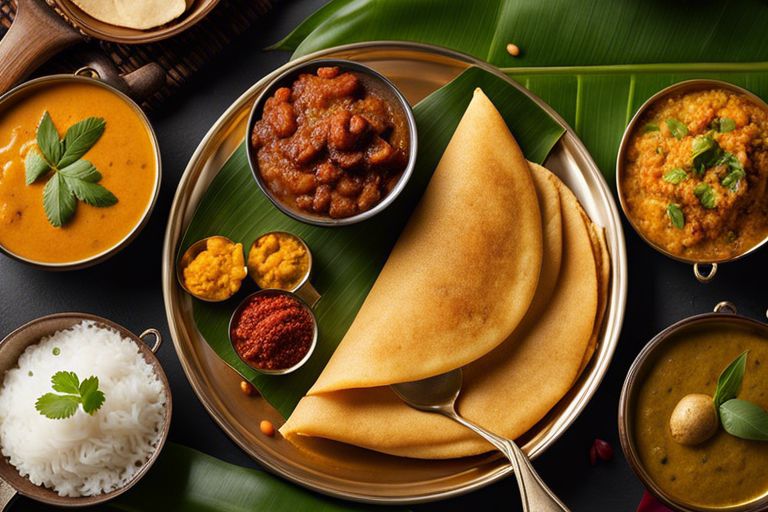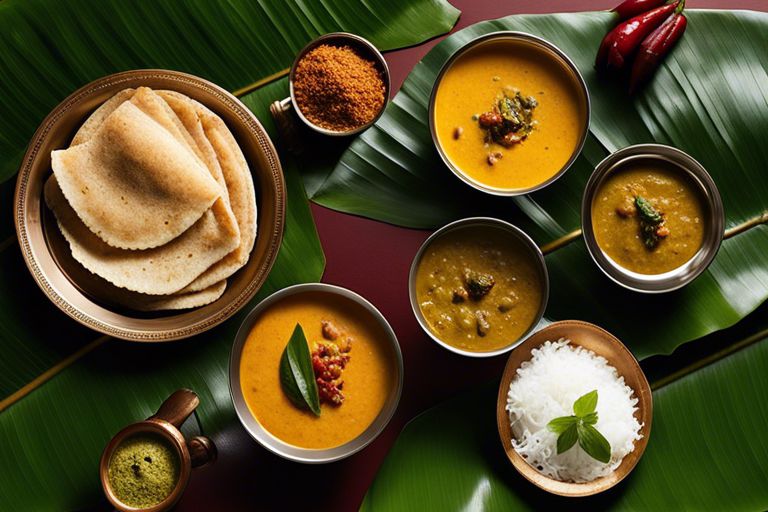Most people who have tasted South Indian cuisine can attest to its unique blend of flavors and aromas. From crispy dosas to flavorful sambar, South Indian cooking is a culinary art that has been perfected over generations. In this blog post, we will explore into the secrets behind the exquisite taste of South Indian dishes, exploring the spices, techniques, and traditions that make this cuisine so special. Whether you’re a seasoned chef looking to expand your culinary repertoire or just someone who appreciates good food, get ready to unlock the mysteries of South Indian cooking and bring a taste of the region into your own kitchen.
Key Takeaways:
- Ingredients: South Indian cooking relies heavily on a variety of spices, coconut, tamarind, and lentils to create complex flavors.
- Techniques: Key techniques include tempering spices, grinding fresh masalas, and using coconut in various forms to enhance the taste of dishes.
- Health Benefits: South Indian cuisine often uses minimal oil, focuses on steaming and frying, and incorporates a variety of vegetables, making it a healthy and flavorful choice for meals.
Historical Roots and Regional Variations
Even though South Indian cuisine is often thought of as a homogenous entity, it actually encompasses a wide array of dishes, flavors, and culinary traditions that vary greatly from state to state and region to region. The historical roots of South Indian cooking are deeply intertwined with the rich tapestry of cultures and civilizations that have flourished in the region over the centuries.
The Evolution of South Indian Cooking
South Indian cooking has evolved over time, influenced by various factors such as geography, climate, agriculture, trade, and foreign invasions. The use of rice, lentils, coconut, tamarind, and a plethora of spices like mustard seeds, curry leaves, and dried red chilies are common elements that bind the cuisine together, yet each state has its own unique take on these ingredients.
Distinctive Flavors Across the South
To the north, Andhra Pradesh is known for its spicy and tangy dishes, often incorporating a generous amount of red chilies and tamarind. In Karnataka, you will find a harmonious blend of flavors with dishes like Bisi Bele Bath and Mysore Masala Dosa. Tamil Nadu, on the other hand, boasts a rich culinary heritage with its famous Chettinad cuisine and traditional vegetarian fare.
Distinctive Flavors Across the South
With the abundance of coconut trees along the coast, coconut plays a significant role in the cuisine of Kerala, where you will find dishes like Kerala Fish Curry and Avial that are rich in coconut milk. The use of fresh seafood and aromatic spices sets Malayali cuisine apart from the rest of the South Indian states.
With a multitude of flavors and cooking techniques to explore, South Indian cuisine offers a truly sensory experience that reflects the diverse cultural landscape of the region. Whether you are savoring a fiery Andhra meal or indulging in the subtle flavors of Kerala cuisine, each dish tells a story of tradition, history, and innovation.
Mastering Fundamental South Indian Recipes
There’s a rich culinary heritage in South India that revolves around delicious and wholesome meals. Mastering the fundamental South Indian recipes is a rewarding experience that allows you to uncover the diverse flavors and techniques that define the region’s cuisine.
The Art of Making Dosa and Idli
With their crispy texture and delightful taste, dosa and idli are quintcrucial South Indian dishes that are enjoyed for breakfast or as a snack. The key to mastering these dishes lies in the fermentation process of the batter, which gives them their signature flavor and lightness. Grinding a combination of rice and lentils to a smooth paste and allowing it to ferment overnight is crucial in achieving the perfect dosa and idli.
Once the batter is fermented, dosa is made by spreading a ladleful of batter on a hot griddle to create a thin, crispy crepe. Idli, on the other hand, is steamed in special molds to achieve its fluffy texture. Serving these dishes with coconut chutney and sambar completes the authentic South Indian culinary experience.
The Secret to Perfect Sambar and Rasam
For a truly authentic South Indian meal, mastering the art of making sambar and rasam is crucial. Sambar is a flavorful lentil-based stew loaded with vegetables and seasoned with a blend of spices like tamarind, coriander, and mustard seeds. Rasam, on the other hand, is a tangy and spicy soup made with tomatoes, tamarind, and a unique spice mix.
Indian households have their own unique variations of these recipes, passed down through generations. The key to achieving the perfect balance of flavors in sambar and rasam lies in the meticulous selection and roasting of spices, as well as the careful combination of ingredients to create a harmonious blend of tastes.
Indian cuisine is known for its intricate flavors and aromatic spices, and South Indian cooking is no exception. Mastering the fundamental recipes like dosa, idli, sambar, and rasam allows you to probe into the heart of South Indian culinary traditions and create authentic dishes that are bound to impress.
The Spices of the South
Now, let’s research into the vibrant world of South Indian spices, where flavors and aromas reign supreme. Each spice plays a crucial role in creating the distinct taste profile that defines South Indian cuisine.
Understanding the Spice Blend – Curry Powders and Masalas
Curry powders and masalas are the heart of South Indian cooking, infusing dishes with layers of complex flavors. These spice blends typically include a mix of coriander, cumin, turmeric, mustard seeds, fenugreek, and other aromatic ingredients, depending on the region and recipe. Each blend is carefully crafted to achieve a perfect balance of heat, sweetness, and tanginess.
Curry powders and masalas can be dry-roasted to enhance their flavors before being ground into a fine powder or paste. This step is imperative for unlocking the full potential of the spices and releasing their imperative oils, which are responsible for the rich, aromatic taste of South Indian dishes.
How to Source and Store South Indian Spices
Powders, whole spices, and blends used in South Indian cooking can be easily found in local Indian grocery stores, specialty spice shops, or online retailers. Look for reputable brands that offer high-quality, fresh spices to ensure the best results in your cooking.
For instance, store spices in airtight containers away from direct sunlight and heat to preserve their potency and flavor. It’s recommended to label each container with the date of purchase to keep track of their freshness. Additionally, whole spices tend to retain their flavor longer than ground ones, so consider grinding them in small batches as needed.
Advanced Techniques and Specialty Dishes
Not just limited to basic recipes, South Indian cooking encompasses a wide array of advanced techniques and specialty dishes that are cherished for their unique flavors and intricate preparation methods. From the elaborate thali meals to the festive foods prepared during special occasions, South Indian cuisine offers a rich tapestry of culinary delights.
- Thali: A South Indian Culinary Odyssey
- Festive Foods: Traditions in South Indian Celebrations
| Thali | Festive Foods |
| A traditional meal served on a banana leaf, comprising of a variety of dishes such as rice, sambar, rasam, poriyal, kootu, and desserts. | Specially prepared delicacies like payasam, vada, and appam are common during festivals and celebrations in South India. |
Thali: A South Indian Culinary Odyssey
South Indian cuisine is renowned for its elaborate thali meals, which offer a gastronomic journey through a diverse range of flavors and textures. The thali typically includes a selection of rice, lentil-based dishes, vegetables, pickles, chutneys, and sweets, all served on a single platter. Each item in the thali is meticulously prepared to create a harmonious balance of tastes, making it a truly satisfying dining experience.
Thalis vary in composition and presentation across different South Indian states, with each region adding its own unique touch to the spread. From the fragrant bisi bele bath of Karnataka to the spicy fish curry of Kerala, thalis reflect the culinary diversity and cultural heritage of the region.
Festive Foods: Traditions in South Indian Celebrations
Foods play a central role in South Indian celebrations, with special dishes prepared to mark auspicious occasions such as weddings, festivals, and ceremonies. These festive foods are symbolic of the rich cultural traditions and religious customs observed in the region. Ingredients like coconut, tamarind, curry leaves, and traditional spices are commonly used to create these delectable dishes that evoke a sense of nostalgia and community spirit.
Indian festivals such as Pongal, Onam, and Navratri are incomplete without the preparation of traditional sweets and savory snacks that are shared with family and friends. These festive foods not only provide a taste of authentic South Indian cuisine but also embody the spirit of togetherness and celebration that define the cultural ethos of the region.

Conclusion
Conclusively, entering into the world of South Indian cooking can be a rewarding and enlightening experience. By understanding the unique spices, flavors, and techniques that define this cuisine, one can uncover a rich tapestry of culinary secrets. Whether you are exploring the vegetarian delights of Tamil Nadu or the fiery curries of Andhra Pradesh, South Indian cooking offers a diverse range of dishes that are sure to tantalize your taste buds. So, gather your ingredients, fire up your stove, and commence on a flavorful journey through the vibrant and aromatic kitchens of South India.
FAQ
Q: What makes South Indian cooking unique?
A: South Indian cooking is known for its generous use of spices, coconut, and tamarind, giving dishes a perfect balance of flavors that are both spicy and tangy.
Q: What are some necessary ingredients used in South Indian cooking?
A: Some key ingredients in South Indian cooking include mustard seeds, curry leaves, coconut milk, tamarind, and a variety of lentils and pulses like toor dal and urad dal.
Q: Can you provide some popular South Indian dishes to try at home?
A: Certainly! Some must-try South Indian dishes include dosa (rice crepe), idli (steamed rice cake), sambhar (lentil stew), rasam (spicy soup), and coconut-based curries like avial and kootu.

